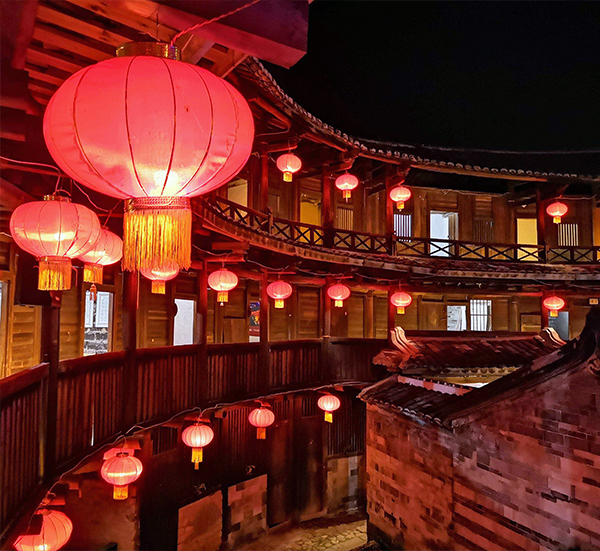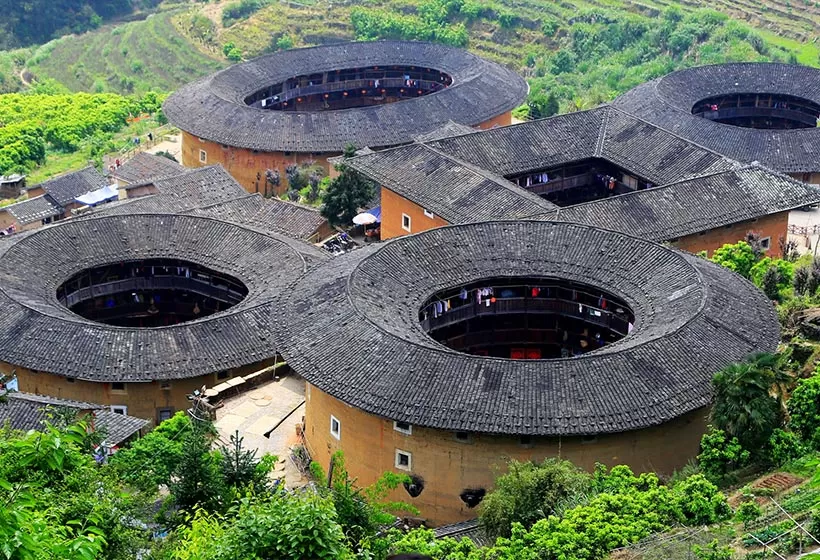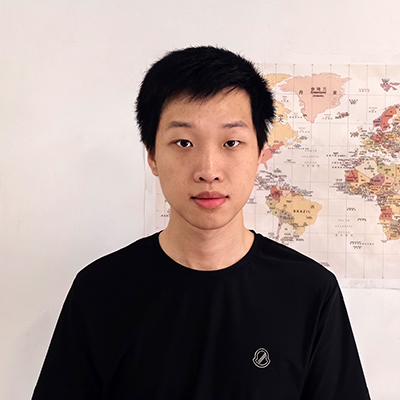Short Introduction to Fujian Local Culture: History, Festival, etc.
Fujian Province, abbreviated as "Min", is located on the southeastern coast of China. It borders Zhejiang to the northeast, and Guangdong to the southwest. To the southeast, it faces Taiwan across the Taiwan Strait.
The representative historical culture of Fujian is known as the "Eight Min Cultures". Strategically positioned between the East China Sea and the South China Sea, Fujian was the starting point of the ancient Maritime Silk Road and Zheng He’s voyages to the Western Seas, serving as a major center for maritime trade. Quanzhou was a world-renowned port and a key point on the Maritime Silk Road during the Song and Yuan dynasties, while Fuzhou was a stopover and departure port for Zheng He’s fleet. Fujian is home to five UNESCO World Heritage Sites, including the dual-listed cultural and natural heritage site of Wuyi Mountain, the cultural heritage of Gulangyu Island, and the Fujian Tulou.
Brief History
The abbreviation for Fujian, "Min", has first appeared in the Classic of Mountains and Seas, referred to a snake-worshipping tribe. During the pre-Qin period, it was part of the Yue ethnic group known as Minyue, and was later conquered by the Qin dynasty.
In 112 BCE, the Minyue kingdom rebelled and was subdued by Emperor Wu of Han. Due to the region's rugged terrain, the Han government relocated the Minyue people to the north and stationed troops to prevent the rebellion. In 207 CE, during the late Eastern Han, Jian'an Prefecture was officially established. During the Three Kingdoms period, Fujian belonged to the state of Wu and became one of its largest shipbuilding bases.
During the Jin dynasty, war in the Central Plains led to the first large-scale migration of Han Chinese into Fujian. In the Southern Chen dynasty, Emperor Wu briefly established Min Region, governed from Jin'an (now Fuzhou), marking the first provincial-level administration in Fujian's history.
At the beginning of the Tang dynasty, Jianzhou replaced Jian'an Prefecture. In 725 CE, the Minzhou was renamed the Fuzhou, marking the first appearance of the name "Fuzhou" and solidifying its status as the provincial capital. In 733 CE, to strengthen frontier defense, a new military commissioner position was created by combining one part each from "Fuzhou" and "Jianzhou", giving rise to the name "Fujian", marking the first appearance of "Fujian".
During the Song dynasties, the Fujian Region was established, with eight administrative machineries in total, hence Fujian's nickname "Eight Min". Also at this time, Fujian became a prosperous hub of Southeast China. With the Silk Road blocked by the Western Xia, maritime trade gained importance, giving rise to the Maritime Silk Road. Quanzhou rose to prominence and became China's largest port. In the Yuan dynasty, Quanzhou became more prosperous until unrest led by Persians in the late Yuan period caused its gradual decline.
In the Ming and Qing dynasties, Emperor Yongle commissioned the construction of 137 ships in Fujian to support Zheng He's voyages, achieving the maritime navigation feat of seven expeditions across the seas. This period saw a population boom and an unprecedented wave of overseas emigration, forming a vast community of overseas Chinese of Fujian origin.
After the Opium War, Xiamen became one of the treaty ports and foreign concessions were established. During the Self-Strengthening Movement period, Zuo Zongtang founded the Fuzhou Naval Shipyard and the Naval Academy, laying the foundation for modern China's navy. After the reform and opening-up, the establishment of the Xiamen Special Economic Zone revitalized Fujian once again.
Regional Culture
Across the land of Fujian, every brick and tile, every blade of grass and tree, is imbued with a rich cultural atmosphere. Regional cultures such as Minnan culture, Hakka culture, Mazu culture, and Maritime Administration culture each possess their own unique charm.
Minnan Culture
Minnan culture is a regional culture jointly created and shared by Minnan people, with a profound influence across East Asia. It is characterized by the use of the Minnan dialect as its medium and a strong maritime cultural identity, marked by distinctive linguistic and regional traits.
Minnan culture began to take shape after the unification of China by Emperor Qin Shi Huang, when Minzhong Prefecture was established, initiating the exchange and integration of Central Plains culture with indigenous Minnan traditions. During the Han, Jin, and Tang dynasties, a large number of Han people from the Central Plains migrated to the Quanzhou area, further promoting the development of Minnan culture. During the Song and Yuan dynasties, Quanzhou became a major port and departure point for the Maritime Silk Road. The arrival of Arab and Persian merchants brought Islamic influences, enriching the local culture. In the Ming and Qing periods, European traders and missionaries introduced Western culture, further enhancing Minnan cultural prosperity.
Minnan culture is the result of generations of social practice by Minnan people, who have continuously explored, promoted, and innovated their heritage. It has also absorbed and integrated elements of foreign cultures, incorporating them organically into its own system to develop into the rich tradition we see today.
Hakka Culture
The Hakka people are a branch of the Han ethnic group in southern China. Historically, they are descendants of Han Chinese who gradually migrated south from the Central Plains due to wars, famine, and other upheavals. Some settled in the tri-border region of Jiangxi, Fujian, and Guangdong, where they intermingled with local indigenous groups such as the She people, eventually forming a distinct and stable Han subgroup. They developed a unique Hakka dialect, cultural customs, and emotional identity.
According to legend, during the early 4th century at the end of the Western Jin dynasty, some Han people living in the Yellow River basin migrated south across the Yangtze River to escape war. Further waves of migration occurred at the end of the Tang dynasty in the 9th century and again in the late Southern Song dynasty in the 13th century, bringing large numbers of Han migrants to Guangdong, Fujian, Guangxi, Jiangxi, and even overseas. To distinguish themselves from the native inhabitants of these regions, the migrants referred to themselves as "guests", or "Hakka people".
Even after relocating to the south, the Hakka never forgot the proud heritage of their Central Plains ancestors. They preserved the memory of their once-prominent family histories by posting ancestral achievements on the walls of ancestral halls and homes, updating them regularly as a constant reminder. The Hakka emphasis on clan origins and the celebration of ancestral glory reflect a deep commitment to upholding and preserving traditional Chinese culture.
Totem Culture
The abbreviation for Fujian, “Min”, first appeared in the ancient text The Classic of Mountains and Seas, where it referred to a snake-worshipping tribe. This reveals the deep and enduring connection between the people of Fujian and snakes. For thousands of years, snakes have profoundly influenced the religious beliefs, folk customs, and spiritual culture of the Min people, giving rise to a unique tradition of snake worship.
A major branch of the ancient Baiyue peoples, the Minyue tribe, lived in the Min River basin and the southeastern hilly and coastal areas of Fujian, where abundant in snakes. They regarded the snake as a clan symbol or totem, believed it to be their ancestral spirit, and worshipped it accordingly. For a long time, the Minyue preserved snake-worship customs, even carving snake shapes on their bodies as a pray of protection against wild animal attacks. Many places also built temples dedicated to the Snake King.
This rich and sincere snake culture deeply permeates Fujian’s folk traditions. In terms of appearance, snakes resemble dragons, and in the Chinese zodiac, the snake is often referred to as the “little dragon”, because folk belief holds that dragons evolved from snakes. In Fujian's folk culture, many romantic tales of humans and snakes have been passed down through generations, especially popular among people in Fujian and Taiwan.
Ethnic Minority
Fujian is a province where diverse cultures converge. In addition to the Han ethnic group, several minority groups have also lived and thrived on this land for generations.
The She ethnic group is the largest minority group in Fujian, scattered across more than 80 counties throughout the province. Most She people live in the southeastern hilly regions, often intermingled with the Han population. The She people refer to themselves as "Shanha", meaning "mountain people" or "guests living in the mountains".
Mountain songs are a central component of She literature, expressed in the unique She language through singing, so She literature is largely oral folk literature. She handicrafts are diverse and distinct in style, with embroidered ribbons and bamboo weaving being the most well-known—these are also the favorite adornments of She women.
Fujian Province is one of the birthplaces of the Hui ethnic group in China. The Hui people are mainly concentrated in areas such as Quanzhou and Putian, with more than 30 Hui villages in the vicinity of Quanzhou alone. These residents are originally descendants of Arabs who settled in various regions due to wars or other historical reasons. Although they practice Islam, most of them have become fully assimilated into Han Chinese culture.
The Manchu people are mainly concentrated in the cities of Fuzhou and Quanzhou, and are primarily descendants of bannermen who were stationed in Fujian during the Kangxi and Qianlong reigns of the Qing Dynasty. They speak a unique Qinjiang Mandarin, which differs from both Manchu and standard Mandarin. They has also preserved many lifestyle features characteristic of the bannerman spirit and influenced with neighboring ethnic groups.
The Gaoshan ethnic group in Fujian mainly resides in Zhangzhou and Nanping, and they migrated from Taiwan. Their culture is rich and diverse. Ancient ballads and lyrical folk songs are representative of their musical traditions, while the Harvest Dance and Pestle Music are distinctive features of their dance and musical heritage. Gaoshan homes are typically wooden houses with thatched roofs.
Special Festivals
Aojiu Festival is celebrated on the 29th day of the first lunar month. On this day, every household prepares a sweet porridge called "Aojiu congee" to offer in ancestral worship or as gifts to relatives and friends. Married daughters are expected to return to their parental homes with a bowl of Aojiu congee and other gifts to show filial respect to their parents. The rich festive atmosphere reflects deep-rooted filial piety.
Singer King Festival, celebrated on the 8th day of the fourth lunar month, commemorates the She ethnic group’s two legendary singers, Zhong Ziqi and Zhong Yi. On this day, the She people hold ritual ceremonies and singing competitions. It is also known as the festival for plow oxen, honoring their year-round labor. Oxen are not to be whipped on this day, and they are fed with fresh forage and the best homemade ox wine in gratitude.
The Mazu Temple Fair is a grand celebration of Mazu culture. With over 200 million Mazu believers worldwide, the festival features events such as lantern-hanging, Puxian opera, puppet shows, martial arts performances, folk dances, and the grand procession of Mazu's sacred palanquin. The direct ferry routes between mainland China and Taiwan have greatly facilitated cross-strait cultural exchanges of Mazu traditions.
Weiya Day is a major celebration in Minnan. On the 2nd and 16th of every lunar month, Minnan merchants traditionally worship the Earth God, a practice called "Zuo Ya". The first Ya on the second day of the second lunar month is called "Tou Ya", and the final one in the twelfth month is "Wei Ya". Today, this tradition has evolved into festive gatherings featuring food, drink, and entertainment, marking the approaching end of the lunar year.
Diet Style
Fujian Cuisine, or Min Cuisine, is one of the Eight Great Cuisines of China. It developed through the fusion of Han culture from the Central Plains and the indigenous Minyue culture. Originating in Fuzhou, it is based on Fuzhou cuisine and later evolved by incorporating the flavors of five regional styles: Eastern Fujian, Southern Fujian, Western Fujian, Northern Fujian, and Putian. In a narrow sense, Min Cuisine refers to Fuzhou cuisine, which originated in Min County, Fuzhou, and later expanded into three major branches—Fuzhou, Southern Fujian, and Western Fujian, collectively known as Min cuisine in the broader sense.
Due to the frequent maritime travel and exchanges of the Fujian people, their culinary customs evolved into an open and distinctive system. Renowned for preparing both mountain and seafood delicacies, Min Cuisine excels in color, aroma, taste, and plating, especially expert in its fragrance and flavor.
Fuzhou cuisine features light, fresh flavors with an emphasis on soup-making and excels in delicacies of mountain and sea. Southern Fujian cuisine (from Xiamen, Zhangzhou, and Quanzhou) focuses on bold seasoning and aromatic freshness. Western Fujian cuisine (from areas such as Changting and Ninghua) leans toward salty and spicy flavors, emphasizing mountain fare. As a result, Min Cuisine is characterized by three key strengths: mastery of red yeast fermentation, expertise in soup preparation, and skillful use of sweet-and-sour flavor combinations.
Fujian also has a tea and alcohol culture that spans thousands of years. In particular, tea drinking has become an integral part of daily life. Since the Tang and Song dynasties, tea competitions were widely popular. Today, the Southern Fujian tea ceremony and the Hakka-style "Lei Cha" (pounded tea) are celebrated both in China and internationally.
Cultural Heritage
Fujian boasts a long and rich history, a land of outstanding people. It has striking natural landscapes, and is also home to a deep and vibrant cultural heritage, with treasured legacies steeped in a strong sense of historical charm.
Wuyi Mountain is home to a diverse array of cultural relics, ancient civilizations, and traditional practices, which is the cradle of Minyue culture and Neo-Confucianism as founded by Zhu Xi. The region's tea culture, with a history spanning over a thousand years, continues to flourish today, making significant contributions to the study of Chinese tea history. The Fujian Tulou, which originated during the Song and Yuan dynasties and matured through the late Ming, Qing, and Republican periods, are unique mountain dwellings, representing the pinnacle of rammed earth construction techniques. Gulangyu Island, once a key gateway for Sino-foreign exchange, blends traditional Minnan architectural styles with classical Western and veranda-style designs, and continues to thrive with vitality in the modern era.
From folk customs and traditional opera to invaluable craftsmanship, Fujian, where is rich in intangible cultural heritage, has nurtured countless brilliant aspects of civilization amidst its scenic landscapes. Min Opera, is the only surviving Chinese opera performed entirely in the Fuzhou dialect, with a unique vocal style that captures the essence of local culture. Nanguan music is one of the oldest surviving musical traditions in China, preserving ancient melodies, tonal systems, and pipa finger techniques for over a thousand years. Fujian paper cutting, a representative of southern Chinese paper art, blends the bold simplicity of the north with the delicate elegance of the south.
Customize Your Eight Min Fujian Tour

If you are interested in the Fujian itineraries mentioned above, please contact us, and we will be happy to customize it and provide a quote tailored to your preferences.
Alternatively, if you would like to customize your Fujian Tour, please visit our Fujian Tour Customized Center. We assure you that you will receive a reply within 24 working hours.
Informative Articles for Your Fujian Trip
 Fujian Tulou
Fujian Tulou- Travel Guide: attractions, weather, culture, etc.
- Weather: best time and seasons to visit Fujian
- Top attractions: sightseeings to watch in Fujian
- Local culture: brief history, folk culture, food, etc.
- Top destinations: best places to visit in Fujian
- Travel itineraries: itineraries for your reference
- Abundant activities: Fujian cultural immersions
- Unique perspective: top interesting things to do
- Local food: what to eat while traveling in Fujian
- Luxury hotels: accommodation to stay in Fujian
- Fujian Tours: customized tours for your reference
GREAT FAMILY CHINA TOUR
JULY 2024 We wanted to thank Grace at China Culture tour for organizing a great tour of China. We enjoyed our Beijing - Xian-Chengdu -Guilin -Yangshuo - Shanghai trip. Our local guides Bruce in Beijing, Susan in Xian, Jane in Chengdu, Mike in Guilin and Mary in Shanghai took care of us…read more details »
Teng Han L from SINGAPORE
Ready to Create a Unique Dream Travel?


